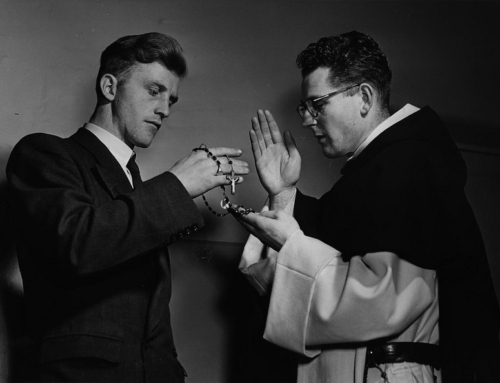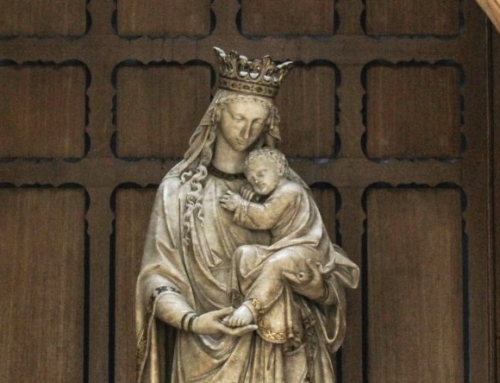Edmund G. Gardner. The Road to Siena: The Essential Biography of St. Catherine of Siena. Edited by Jon M. Sweeney. Brewster, MA: Paraclete Press, 2019. xii + 205 pp.
Edmund Gardner’s The Road to Siena: The Essential Biography of St. Catherine of Siena, originally published in 1907, and now reprinted with copious editing and notes by Jon Sweeney, joins other recent reprints of biographies of St. Catherine by Nobel Laureate Sigrid Undset and Catherine’s own confessor, Bl. Raymond of Capua. Despite the excellent quality of these other works, there are good reasons to pick up Gardner’s as well. Short and accessible, Gardner’s biography provides some helpful historical contextualization, making it a welcome addition to the library of anyone interested in the history of the Church and her saints.
Gardner’s introduction summarizes his own methods and sources as well as the literary output of St. Catherine. The first seven chapters then chronicle her upbringing and unexpected rise to prominence, along with the history of the Church during the papal residence in Avignon. Chapters 8–13 deal with Catherine’s engagement in high-level ecclesiastical politics and provide a great deal of information about the outbreak of schism in 1378. The final three chapters discuss Catherine’s death and legacy. Sweeney’s notes, given in sidebars throughout, provide additional historical context and references to modern discussions related to St. Catherine. His notes range from necessary explanations to curious tangents, and are designed so that the reader can easily skip what does not interest him or her.
Gardner crafted his work with all the care proper to a historian. We are able to delve into, for example, the plague and its effects on society and culture, corruption in the Church leading to the schism, and the mission of Bridget of Sweden, a papal advisor immediately before Catherine. Gardner’s highly detailed account explains how the outbreak of the schism impacted Catherine immensely, intensifying her mission of prayer and penance for the struggling Church. Sweeney makes the book somewhat more accessible to a general audience, removing some technical material, such as discussions of manuscripts and dating of primary sources (he notes that this work is rather dated by now, anyway), and moving some of the concluding material to the introduction to help orient the modern reader (x). The result is a very accessible account that gives the reader enough context to understand the difficulties which Catherine faced, but without becoming excessively technical.
Sweeney’s notes fill in details concerning such matters as debates about poverty, the effects of the Black Death on the culture, Catherine’s correspondents, Ultramontanism, and the precedent for holy women to be involved in Church politics. These help the reader understand the difficulty of Catherine’s position when attempting to make peace between the pope and her fellow Tuscans or trying to defend the true pope during the schism, among other examples.
Gardner often dwells on historical events which, while related to Catherine’s work, do not directly involve her. The long section on the outbreak of schism, for example, hardly mentions her. These pages may try the patience of the reader more interested in episodes from the saint’s life. Although the book is for the most part accessible and fun to read, the prospective reader should know beforehand that historical contextualization forms a major component of the work.
Properly explaining St. Catherine’s extreme penitential practices, particularly her fasting, presents a common problem for contemporary authors. Gardner, for the most part, is fairly matter of fact. He points out that other saintly women in the Church undertook intense penances, and that Catherine did so for the salvation of souls. Sweeney adds a few notes of his own on this subject. He points out that St. Catherine’s practices, which stemmed from Christ’s self-denial, would have seemed far less bizarre to her contemporaries, and reflected the common view subordinating the body to the soul (23). In a longer note, entitled “Would Catherine be Considered a Masochist Today?”, Sweeney distinguishes between “nervous” and “holy” anorexia, suggesting that Catherine and other saints suffered from the second kind (26). Sweeney then pivots to speculate about the role of food and fasting in the lives of saintly women. The nature of St. Catherine’s fasting presents a real and difficult question. She herself described her inability to eat, even when she wanted to, as a sickness. Sweeney’s speculations may provide some possible insights, but readers uncomfortable with Catherine’s asceticism may not find much reassurance here. Sweeney is at least clear that Catherine’s holiness is real, and not simply a mental disorder.
Inevitably, the focus on historical context and the brevity of the work (about 200 pages) mean that Gardner had to leave out some material. A lessened emphasis on miracle stories, especially compared to Bl. Raymond’s Life of Saint Catherine of Siena, marks Gardner’s biography. Sweeney argues that Gardner’s original work, because of the times in which he wrote tended to minimize the supernatural or provide rational explanations (196–197). Nonetheless, Gardner does not give the appearance of “explaining away” Catherine’s holiness, but instead relates some of her visions, her mystical experiences, and the miraculous conversions worked by her prayers. Most of these are confined to the initial chapters, however, before the emphasis shifts to Catherine’s political involvement.
Other personal elements of Catherine’s life also find less space. For example, the agony of her death is given some attention, but Gardner leaves out many of the details of the slow and painful decline of Catherine’s health under the demands of her life. Her death, then, seems to come about somewhat suddenly, rather than as the culmination of her short but intensely ascetical life. Gardner sacrifices much of this material in order to better describe Catherine’s political involvement. He does, fortunately, make abundant use of her letters, which helps to bring out her personality. Her dramatically blunt yet humbly deferential advice to Pope Gregory XI serves as a prime example.
Gardner’s work is ideal for anyone who wants a brief introduction to St. Catherine and the world in which she acted. Numerous quotations from her letters and judicious historical explanations help draw us into her mind, even though much of the narrative of her personal life is abbreviated. The already-knowledgeable fan of St. Catherine may find that this book provides valuable historical context and insights in a short and readable format. Someone seeking a more traditional hagiographical account of the miracles of St. Catherine’s life should perhaps look instead to Raymond’s Life of Saint Catherine of Siena.
Reviewed by Br. Raymond La Grange, O.P.
✠
Download a PDF of this article here



